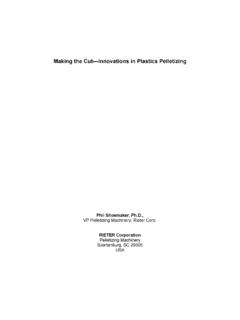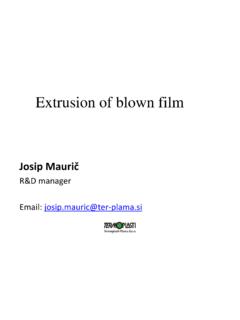Transcription of Powders into Liquids - Powder Technologies Inc
1 Powders into Liquids Dustfree Induction and Dispersion Hans-Joachim Jacob, Rick Isherwood Mixing of Powder into liquid is very easy: You simply pour it onto the surface of the liquid and then you mix it in. It is quite clear that this creates a lot of dust pow-der falls beneath the vessel but knifes and other equipment may fall into the vessel instead. It is obvious that Powder sticks to the walls of the vessel and other devices inside and it is supposed to be normal, that lumps and agglomerates are built up when the Powder comes in contact with the liquid . It takes a long time and strong shear to break and disperse them again.
2 The addition of Powders into Liquids is known as dusty, dirty and unhealthy, for the operator as well as for the process. But there are other ways and Authors: Dr. Hans-Joachim Jacob, ystral Rick Isherwood, PTI TDS machines are systems which induct Powder dust- and loss-free directly from a bag into the liquid . The Powder is wetted either below the liquid surface or inline in a self circulated external loop. It is dispersed immediately and completely agglomerate free (TDS = Transport and Dispersing Sys-tem). No dust sticks to the wall of the ves-sel, no bag has to be lifted on top of the tank or to a filling tray.
3 Different from any conventional Powder transporting or conveying system the TDS-machines do not require any additional air for fluidisation or transportation, no filters, no dust extraction and of course no addi-tional equipment to produce the vacuum. They produce the vacuum directly in the liquid and this way they induct the Powder 100% loss free into the liquid . You can in-duct Powders into a standard vessel an expensive vacuum vessel is not required. Dust-free handling with TDS induction mixers The TDS induction mixer is a special ver-sion of the Jetstream mixer. Jetstream mix-ers are well known for their very effective vertical mixing of the Liquids in vessels.
4 They are known for a much higher homo-geneity compared to any other stirrers. The mixing head consists of a rotation hyper-boloid shaped guiding tube the stator. In the centre of the stator a fast turning impel-ler rotates and forces a strong stream of liquid downwards to the bottom of the ves-sel. On the bottom, the stream is redirected along the wall of the vessel upwards until it reaches the surface of the liquid . Finally it moves back to the mixing head. That way the complete content of the vessel is verti-cally circulated and homogeneously mixed. This mixing principle is recommended es-pecially for solid- liquid blends, because the solid typically tends to sediment at the bot-tom of the vessel.
5 A Jetstream mixer avoids sedimentation totally. The TDS induction mixer produces a strong vacuum in the centre of its rotor. This vacuum is being used to induct pow-der material. The Powder is typically in-ducted using an induction tube and induc-tion hose. The complete wetting of the Powder is effected in the mixing head be-low the surface of the liquid . Because of the enormous turbulences in the fast rotat-ing rotor there is an immediate and inten-sive micro mixing of Powder and liquid to-gether. No dust comes out of the liquid . Pict 1.: Dust free Powder induction with TDS induction mixer PowderLiquidDispersionStator Rotor Rotor qVacuum increasesqAir between particles expandsqDistance between particles increasesqParticles are acceleratedExit from the Dispersing chamberDispersing ZoneEntry into the Dispersing ChamberqBetween rotor and stator high-shear dispersion under vacuumqIn this phase maximum vacuum.
6 Maximum distance between particles qSpecific surface of the liquid is enlarged million timesqEvery single particle is wetted and dispersed completelyqMaximum pressureqMinimum distance between particlesqAir is compressedqCoagulation of the air bubblesqVacuum increasesqAir between particles expandsqDistance between particles increasesqParticles are acceleratedExit from the Dispersing chamberDispersing ZoneEntry into the Dispersing ChamberqBetween rotor and stator high-shear dispersion under vacuumqIn this phase maximum vacuum, maximum distance between particles qSpecific surface of the liquid is enlarged million timesqEvery single particle is wetted and dispersed completelyqMaximum pressureqMinimum distance between particlesqAir is compressedqCoagulation of the air bubblesNo Powder sticks on the shaft of the mixer, on the wall of the vessel or on devices in-side.
7 No crusts or agglomerates are being built up. When Powder is inducted out of a bag no dust appears even around the bag. The reason is simply sucking Powder out of the bag creates an air flow from the outside into the bag. Because of this effect, no dust can come out of the bag during the induc-tion procedure. The bags are completely emptied. If just a part of the Powder in the bag is required for the process, the bag may be placed on a scale and the required amount of Powder can be dosed exactly. TDS induction mixers have proved them-selves in many cases where dusty, dirty and harmful Powders such as black carbon, pigments, silica or diatomaceous earth have to be mixed into low viscous Liquids .
8 Because of current discussion about the risks of fine dust in the air, the population naturally is very sensitive against any kind of dust in the air. Dust with a particle size below 10 m is considered as fine dust. The maximum permissible exposure limits are given in ppm. Persons use to handle such materials in the industry may know very well that these limits are never ad-hered to when pouring Powder into an open vessel. The risk for the operator is reduced to a minimum TDS machines make it possible to empty Powder bags and to add Powder into Liquids dust-free. The risk for the operator is re-duced to a minimum. Just when the full bag is opened or when the empty bag is com-pacted there is a minimum risk of dust.
9 For this reason the use of TDS induction mix-ers is recommended by Employer s Liabil-ity Insurance Associations. TDS induction mixers which are installed inside the vessel may be used for a wide range of products but unfortunately they also have limitations. The viscosity of the basic liquid may not exceed 1000 mPas. Thickeners or sticky Powders cannot be in-ducted with this machine. The filling level in the vessel must follow certain conditions and the maximum length of the machine is limited. For this reason an improved TDS machine has been developed: the Conti-TDS. This machine can be used for almost every Powder , every viscosity and every batch size.
10 The Conti-TDS is an Inline dispersing machine that produces a strong induction vacuum in its dispersing zone. This vac-uum is used to induct Powders dust-free from bags, hoppers, containers, BigBags or silos into a liquid . The machine can work Pict 2.: Installation of the Conti-TDS Pict 3.: Powder and liquid are mixed in the Dispersing Chamber Pict 4.: Wetting and Dispersing Zone of the Conti-TDS with any viscosity that can be pumped and even sticky Powders are no problem. The machine is installed outside the vessel and connected to the vessel via pipes ore flexi-ble hoses.







